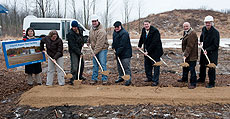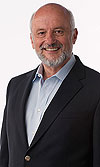|
Have a safe day!
Tuesday, Jan. 24
3:30 p.m.
DIRECTOR'S COFFEE BREAK - 2nd Flr X-Over
THERE WILL BE NO ACCELERATOR PHYSICS AND TECHNOLOGY
SEMINAR THIS WEEK
Wednesday, Jan. 25
3:30 p.m.
DIRECTOR'S COFFEE BREAK - 2nd Flr X-Over
4 p.m.
Fermilab Colloquium - One West
Speaker: Hugh Montgomery, Thomas Jefferson National Accelerator Facility
Title: Jefferson Lab: The Next Ten Years and Beyond
Click here for NALCAL,
a weekly calendar with links to additional information.
Upcoming conferences
|
|
Tuesday, Jan. 24
- Breakfast: Bagel sandwich
- Tomato bisque soup
- Lemon pepper club
- Liver & onions
- Smart cuisine: Korean garlic chicken
- Grilled chicken Casaer salad wrap
- Assorted calzones
- Rio Grande taco salad
Wilson Hall Cafe Menu
|
|
Wednesday, Jan. 25
Lunch
- Crispy chipotle lime tilapia w/ avocado sauce
- Corn & black bean salad
- Cold lime soufflé
Friday, Jan. 27
Dinner
- French onion soup
- Medallions of beef with merlot sauce
- Potato gratin
- Steamed green beans
- Marzipan cake w/ bittersweet chocolate sauce
Chez Leon Menu
Call x3524 to make your reservation.
|
|
Innovation at Fermilab:
Liquid Argon Test Facility
 |
| From left: Fermilab Deputy Director Young-Kee Kim; Gina Rameika, PPD; Kevin Bomstad and Jason Whittaker, Whittaker Construction and Excavation; Dixon Bogert, Fermilab; Mike Weis, DOE; Fermilab Director Pier Oddone; Erik Gottschalk, PPD. Photo: Reidar Hahn
|
Despite the biting cold and snow, scientists and Fermilab personnel gathered outside to break ground for Fermilab's new Liquid Argon Test Facility. The facility, expected to be completed spring 2013, will house liquid-argon based experiments.
Scientists have speculated since the 1980s that liquid argon could be used as a crash pad for high-energy neutrinos and have subsequently constructed several liquid-argon neutrino detectors; the largest and most prominent being ICARUS, the Imaging Cosmic And Rare Underground Signals, detector in Italy. The design of the new MicroBooNE experiment improves upon technology developed for ICARUS and will allow scientists to observe neutrinos with greater precision and resolution.
Regina Rameika is the project manager for the construction of the MicroBooNE detector.
"The MicroBooNE detector that will first use this facility is smaller than ICARUS, but incorporates some advanced designs," Rameika said.
MicroBooNE will use liquid argon as a target for neutrinos generated in the Booster neutrino beam. When the neutrinos hit the argon nuclei, they generate showers of charged particles that then drift to an electrical detector. The purer the argon, the further the particles are able to drift. MicroBooNE will use ultrapure argon to maximize the distance these particles drift. This model is more efficient, cost effective, and has the potential to be scaled-up to a much larger size than previous detectors.
The MicroBooNE experiment will provide another layer of data for using the Booster neutrino beam. Not only will scientists be able to observe particles with the existing MiniBooNE detector, but now they will be able to measure neutrinos from the Booster neutrino beam with a second, higher-resolution detector.
"The MicroBooNE experiment will be focused on understanding some anomalies observed in the data from the MiniBooNE experiment," Rameika said. This project will also provide valuable insight into different designs for liquid-argon detectors that could be located in the LArTF once MicroBooNE is complete.
—Sarah Charley
|
Fermilab Colloquium with Hugh Montgomery - Jan. 25
Hugh Montgomery, director of the Thomas Jefferson National Accelerator Facility and the former associate director of research at Fermilab, will give a lecture at 4 p.m. on Wednesday, Jan. 25, in One West. The talk, titled, "Jefferson Lab: The Next Ten Years and Beyond," is part of the Fermilab Colloquium series. Coffee will be served before the talk at 3:30 p.m.
|
Correction: Fermilab Tuition Assistance Program recipients
In the Friday, Jan. 20, issue of Fermilab Today, a special announcement congratulating the degree recipients from Fermilab's Tuition Assistance Program incorrectly stated who received which degree. The listing should have read that Martha Garcia, FE, received an AA in Applied Sciences, and Stephen Cozzens, AD, recieved a BS in Business Administration.
|
The perfect liquid - now even more perfect
From the Vienna University of Technology, Jan. 23, 2012.
Previous theories imposed a limit on how 'liquid' fluids can be -- but new calculations show that quark-gluon-plasma in high-energy particle accelerators can be even have a lower viscosity than this limit suggests
How liquid can a fluid be? This is a question particle physicists at the Vienna University of Technology have been working on. The "most perfect liquid" is nothing like water, but the extremely hot quark-gluon-plasma which is produced in heavy-ion collisions at the Large Hadron Collider at CERN. New theoretical results at Vienna UT show that this quark-gluon plasma could be even less viscous than was deemed possible by previous theories. The results were published in Physical Review Letters and highlighted as an "editors' selection".
Liquids and their Viscosity
Highly viscous liquids (such as honey) are thick and have strong internal friction, quantum liquids, such as super fluid helium can exhibit extremely low viscosity. In 2004, theorists claimed that quantum theory provided a lower bound for viscosity of fluids. Applying methods from string theory, the lowest possible ratio of viscosity to the entropy density was predicted to be ħ/4π (with the Planck-constant ħ). Even super fluid helium is far above this threshold. In 2005, measurements showed that quark-gluon-plasma exhibits a viscosity just barely above this limit. However, this record for low viscosity can still be broken, claims Dominik Steineder from the Institute for Theoretical Physics at Vienna UT. He obtained this remarkable result working as a PhD-student with Professor Anton Rebhan.
Read more
|
Research matters: Behind every breakthrough lies first-class infrastructure
From The Independent, Jan. 19, 2012.
World-class research needs facilities that evolve and keep pace with its advances
Excellent researchers need excellent facilities if they are to push forward the frontiers of knowledge. In November 2011, researchers at CERN discovered hints of the biggest breakthrough in the history of particle physics, the Higgs boson particle. Finding proof that the Higgs boson exists would illuminate why particles have certain mass and help answer fundamental questions about the creation of the universe. Investment in this remarkable facility has produced five Nobel Prizes and generated countless discoveries, not least the invention of the World Wide Web, on which all of us now rely. It is now the largest particle physics laboratory in the world and UK researchers are among those from more than 20 countries who have the opportunity to work there.
Research Councils UK gives researchers access to a full range of world-class facilities, both in the UK and abroad, because we believe this is vital if we are to remain research leaders.
Read more
|
|
Next step for the Long-Baseline Neutrino Experiment
 |
|
Fermilab Director Pier Oddone |
The LBNE collaboration is now quite a formidable enterprise with over 300 collaborators from more than 60 institutions including six national laboratories, and it is growing. The project is very ambitious with a program to reach unprecedented sensitivity and precision for addressing the neutrino mass hierarchy, CP violation in neutrino mixing, the value of the mixing parameters including precision measurement of θ13. While the primary goal of LBNE is to study neutrino oscillations it will also provide new capabilities to search for nucleon decay, observe neutrinos emitted by supernovae in our galaxy and beyond, and address other important topics in physics and astrophysics.
Under the leadership of its elected spokespersons, Bob Svoboda and Milind Diwan, the collaboration has gone through an exhaustive process to make a series of major decisions that affect the LBNE experimental configuration. The latest decision in this series, the selection of detector technology, took place over the last few weeks. Making these decisions has involved physics studies, analysis of the technical feasibility of various configurations and external reviews organized by the collaboration.
Last fall, after analyzing various options for the generation of the beam at Fermilab, the first major decision was reached. There was unanimity in selecting a beam configuration where the beam first climbs a hill before heading underground towards the Homestake Mine. This configuration makes construction easier, protects the aquifer and minimizes the depth of the near detector compared to the alternate configurations.
Another important decision has been the decision on the depth of the experiment. There is a very strong consensus that the physics reach and breadth of the program is greatly enhanced by building the facilities at a depth of 4850 feet at Homestake. This benefits the LBNE program but also will make it possible for other smaller but very important experiments to take place. The direct search for dark matter and the search for neutrino-less double beta decay could take place economically with the developments made for LBNE. Together with LBNE these experiments will be an important part of the future national physics program.
By far the toughest decision has been the selection of the technology for the detector. The decision is difficult for good reasons: both the liquid-argon TPC technology and the water Cerenkov technology are viable options with different strengths and weaknesses. Both involve a significant scale-up of existing technology, although the challenge is greater for the liquid-argon technology than for the water. On the other hand, liquid-argon technology offers great potential because of the extraordinarily detailed information on each neutrino event.
The decision-making process established by the collaboration for the technology choice called for the project manager to make the final recommendation before seeking the concurrence of the Fermilab director, the Laboratory Oversight Board and the DOE. In the presence of consensus the decision would have been relatively easy. As the established process developed, however, the decision turned out to be a very difficult one as explained in detail in the documentation for the technology choice.
The decision is to build LBNE with liquid-argon TPC technology. This constitutes the preferred alternative as we go into the CD-1 review. Back-up alternatives must be presented at the CD-1 review and we have a ready alternative with the water Cerenkov technology. Because a lot of work was done on the water Cerenkov technology we will make sure to capture and complete the important parts of that research effort. Most of the effort in the next few months, however, will go into studying all the aspects of the liquid-argon detectors and infrastructure. The LBNE experiment built on this technology will be a phenomenal achievement and one that will require the most demanding work from the laboratory and the collaboration, integrating everyone in this very ambitious enterprise.
|
|